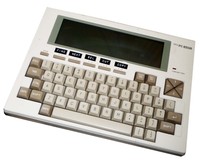NEC PC-8201A
| Home > Browse Our Collection > Computers > NEC Corporation > NEC PC-8201A |
|
In 1983 Kyoto Ceramics, Kyocera, started manufacturing a series of light weight battery powered computers based on a CMOS microprocessor called the 8Oc85. There were eight variations produced under four brand names. Seven were built by Kyocera, including the Tandy 100, and one by NEC, the PC820la/PC8300. All eight variants shared certain features: Powered by 4 AA batteries or an optional 6 volt AC adapter. Screen display 40 characters wide and 8 lines long on an LCD screen. Size of a 3 ring notebook. Text Editor (TEXT), BASIC programming language (BASIC), and telecommunications (TELCOM) software permanently in ROM. Ability to take programs on an optional ROM socket. Full size keyboard. Minimum of 8K RAM installed for programs and files. (Most had more) Weight under 5 pounds. Could save and load programs and data from a cassette recorder with a special cable. Simple text based point and shoot interface. Sort of a text Macintosh. In addition... the NEC PC8201a had: 16K RAM installed, expandable to 2 banks of 32K each. (This one has 32K) Internal 300 baud modem. Redefinable screen character set. Could take memory cartridges up to 128K in a special expansion slot. Video monitor interface available. Portable disk drive available. Portable printer available. Standard telephone connection for modem The Kyocera KC85, Tandy 100/ 102/200 and Olivetti were all produced by Kyocera as the NEC PC820la/8300 were produced by NEC. Tandy had the best distribution network and probably the most common, where the NEC is seldom encountered, probably due to its limited production and availability. ORIGIN Japan YEAR 1983 BUILT IN LANGUAGE Microsoft BASIC 1.0 KEYBOARD Full-stroke 67-key with 5 function keys and arrow keypad CPU Intel 80C85 SPEED 2.4 576 MHz RAM 16 KB up to 64 KB internally, and 128 KB via IC sockets underneath unit ROM 32 KB (standard, up to 64 KB) TEXT MODES 40 chars. x 8 lines GRAPHIC MODES 240 x 64 dots COLOrsc Monochrome SOUND 4 channels, 3.5 octaves SIZE / WEIGHT 30 (W) x 21.3 (D) x 3.3 (H) cm. / 1.7 kg I/O PORTS RS 232 (DSUB 25 pin type), SIO1, SIO2 connectors, 8 pin duPont BERG modular jack - 3 megabytes/minute max transfer CMT socket - 8 pin DIN plug for cassette recorder. Standard centronics printer port, Bar code reader socket - 9 pin DSUB connector, SYSTEM SLOT - for ram cartridges (programs, software etc.) BUILT IN MEDIA CMOS battery backup RAM POWER SUPPLY 4 x AA batteries, NiCad battery pack or AC adaptor (DC 6-8.5V, 600mW) PERIPHERALS External FD units, RAM expansion, external monitor adaptor, bar-code reader PRICE $675 - £546 The NEC PC-8201A is an example of the application of simple technology to relatively simple tasks. The NEC has only three built-in applications, (1) the BASIC computer programming language, (2) the TEXT editor, and (3) the TELCOM terminal emulator. There is no hard disk. There is no floppy disk. There is no backlighting on the display. The display is a black and white reflective LCD. The laptop runs on four AA batteries. Manufacturer: NEC Comment on This Page Magazines RELATED to NEC PC-8201A in our Library
Other Systems Related To NEC PC-8201A:
This exhibit has a reference ID of CH16680. Please quote this reference ID in any communication with the Centre for Computing History. |
|











